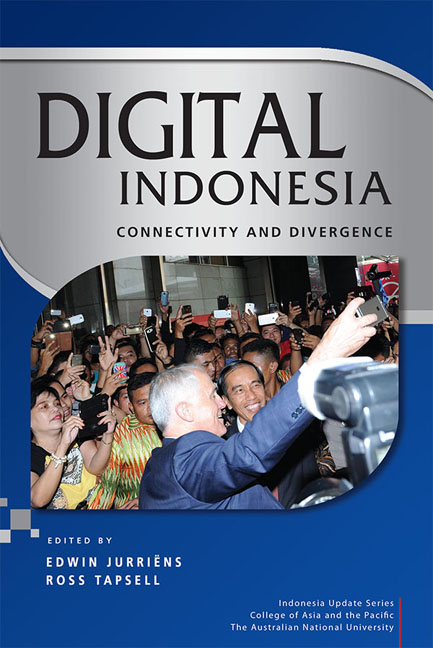Book contents
- Frontmatter
- Contents
- Tables
- Figures
- Contributors
- Acknowledgments
- Glossary
- Map of Indonesia
- 1 Challenges and opportunities of the digital ‘revolution’ in Indonesia
- PART 1 CONNECTIVITY
- 2 An insider's view of e-governance under Jokowi: political promise or technocratic vision?
- 3 Mobile phones: advertising, consumerism and class
- 4 The political economy of digital media
- PART 2 DIVERGENCE
- PART 3 IDENTITY
- PART 4 KNOWLEDGE
- PART 5 COMMERCE
- Index
- Indonesia Update Series
2 - An insider's view of e-governance under Jokowi: political promise or technocratic vision?
from PART 1 - CONNECTIVITY
Published online by Cambridge University Press: 12 January 2018
- Frontmatter
- Contents
- Tables
- Figures
- Contributors
- Acknowledgments
- Glossary
- Map of Indonesia
- 1 Challenges and opportunities of the digital ‘revolution’ in Indonesia
- PART 1 CONNECTIVITY
- 2 An insider's view of e-governance under Jokowi: political promise or technocratic vision?
- 3 Mobile phones: advertising, consumerism and class
- 4 The political economy of digital media
- PART 2 DIVERGENCE
- PART 3 IDENTITY
- PART 4 KNOWLEDGE
- PART 5 COMMERCE
- Index
- Indonesia Update Series
Summary
This chapter provides an insider's perspective on some aspects of the digital strategy of the Joko Widodo (Jokowi) administration—both authors hold positions in the Executive Office of the President (Kantor Staf Presiden, or KSP). Among the priorities Jokowi has continuously emphasised is the need to enhance the nation's competitiveness (Ministry of State Secretariat 2014). As he often said during his presidential campaign, one way to achieve this is to make all government services available and accessible online. Another motivation for promising to introduce a full range of electronic services, from e-planning and e-budgeting through to e-catalogue, e-procurement and even e-complaint handling, was to realise the benefits of e-governance for government administration. Jokowi anticipated that the roll-out of electronic government would help to reduce corruption and improve the transparency and accountability of the bureaucracy, in addition to widening the participation of citizens in policy-making (Ministry of State Secretariat 2014). That is, he saw putting government services online as a means not only to deliver better public services and facilitate collaboration, but also to bolster the credibility of his government (Raharjo 2015).
E-governance has transformed the way governments deliver services to citizens, increasing the convenience, efficiency and transparency of interactions (Carter and Belanger 2004). The core elements of e-governance are information and communication technology (ICT), organisational change and new skills (Pina, Torres and Acerete 2007). E-governance improves public services and democratic processes and strengthens public support for government programs by increasing the quantity and quality of government interactions with citizens and businesses (Denhardt and Denhardt 2000).
This chapter offers a critical perspective on the Jokowi administra-tion's e-governance strategy. It aspires to draw out some of the lessons that have been learned so far: what has worked and what has not; which factors have enabled or constrained implementation; and the strengths and weaknesses in the overarching framework. This is important, because there are always consequences—both intended and unintended—that need to be taken into account when implementing any ambitious government program (Chen et al. 2006). Through an examination of how e-governance is being implemented by the Jokowi administration, we hope to reach an understanding of whether the president's vision is on track to be realised, or will remain in the realm of political promise.
- Type
- Chapter
- Information
- Digital IndonesiaConnectivity and Divergence, pp. 21 - 37Publisher: ISEAS–Yusof Ishak InstitutePrint publication year: 2017

